Quality Analysis in Healthcare: Addressing Student Concerns Report
VerifiedAdded on 2023/04/24
|11
|1829
|215
Report
AI Summary
This report provides a quality analysis of healthcare services in walk-in urgent care clinics, addressing student complaints regarding long waiting times, service quality, and follow-up care. Using tools like the fishbone analysis and run and control charts, the report interprets data from the past nine months to identify key factors contributing to the issues. The fishbone analysis explores environmental, methodological, equipment-related, human, and material factors affecting waiting times. The run and control charts visually represent complaint data, highlighting trends and stability in service quality. Based on the analysis, the report recommends revamping scheduling processes, implementing queue management strategies, delegating documentation, gathering patient information prior to appointments, and integrating telehealth solutions to improve overall patient care and satisfaction. The goal is to optimize resource utilization and enhance the effectiveness of critical and urgent clinical care.

Running head: QUALITY ANALYSIS IN HEALTHCARE
Topic- Quality Analysis in Healthcare
Student name
University name
Author notes
Topic- Quality Analysis in Healthcare
Student name
University name
Author notes
Paraphrase This Document
Need a fresh take? Get an instant paraphrase of this document with our AI Paraphraser
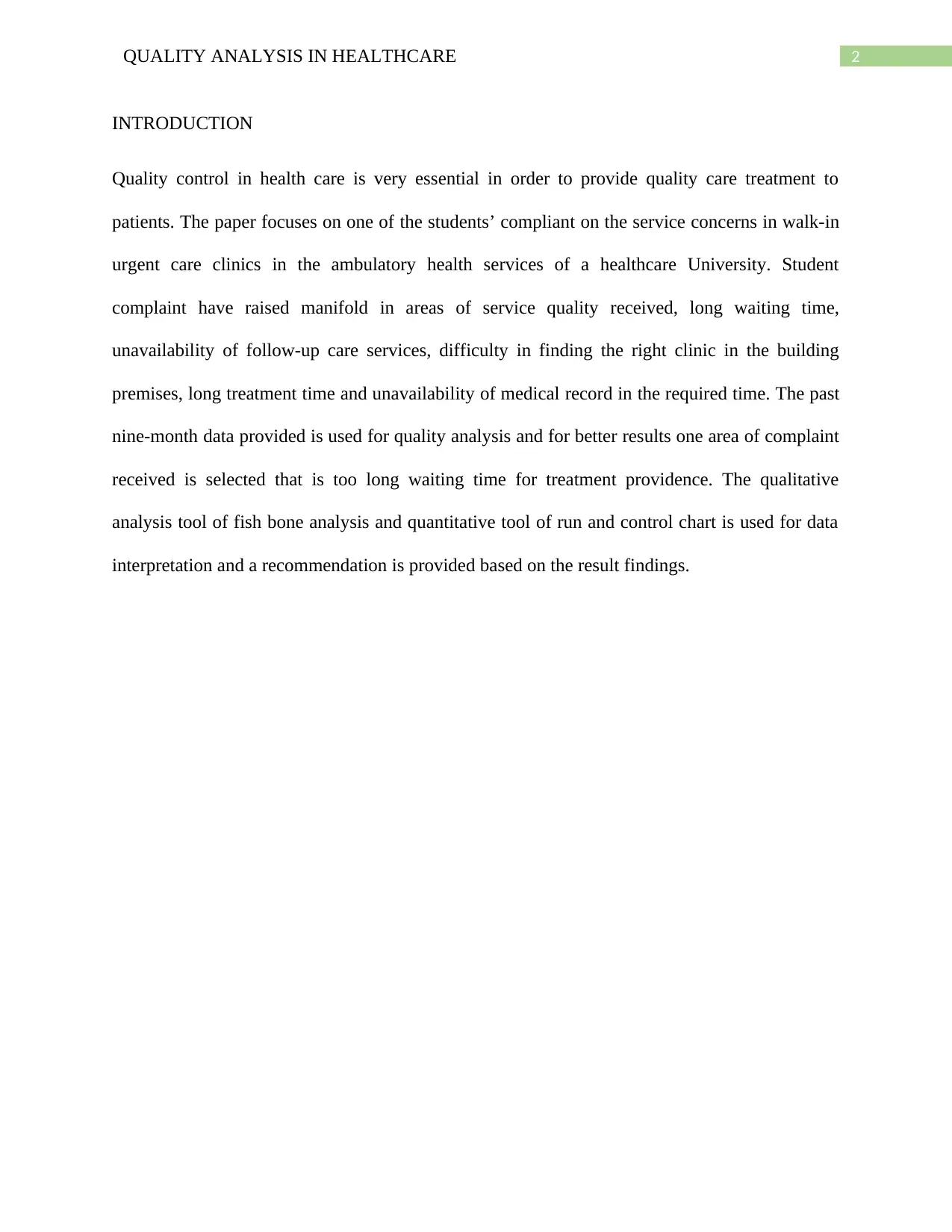
2QUALITY ANALYSIS IN HEALTHCARE
INTRODUCTION
Quality control in health care is very essential in order to provide quality care treatment to
patients. The paper focuses on one of the students’ compliant on the service concerns in walk-in
urgent care clinics in the ambulatory health services of a healthcare University. Student
complaint have raised manifold in areas of service quality received, long waiting time,
unavailability of follow-up care services, difficulty in finding the right clinic in the building
premises, long treatment time and unavailability of medical record in the required time. The past
nine-month data provided is used for quality analysis and for better results one area of complaint
received is selected that is too long waiting time for treatment providence. The qualitative
analysis tool of fish bone analysis and quantitative tool of run and control chart is used for data
interpretation and a recommendation is provided based on the result findings.
INTRODUCTION
Quality control in health care is very essential in order to provide quality care treatment to
patients. The paper focuses on one of the students’ compliant on the service concerns in walk-in
urgent care clinics in the ambulatory health services of a healthcare University. Student
complaint have raised manifold in areas of service quality received, long waiting time,
unavailability of follow-up care services, difficulty in finding the right clinic in the building
premises, long treatment time and unavailability of medical record in the required time. The past
nine-month data provided is used for quality analysis and for better results one area of complaint
received is selected that is too long waiting time for treatment providence. The qualitative
analysis tool of fish bone analysis and quantitative tool of run and control chart is used for data
interpretation and a recommendation is provided based on the result findings.
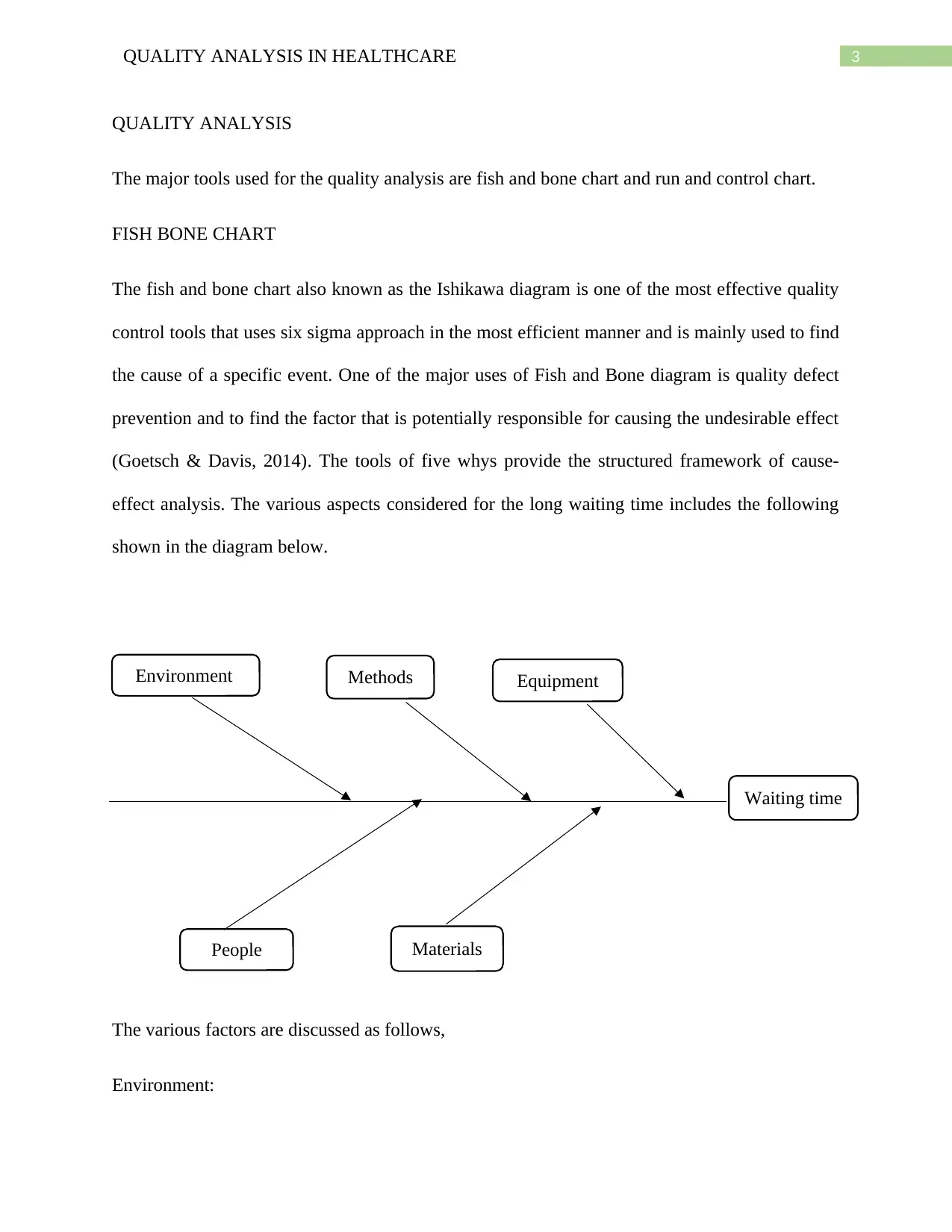
3QUALITY ANALYSIS IN HEALTHCARE
QUALITY ANALYSIS
The major tools used for the quality analysis are fish and bone chart and run and control chart.
FISH BONE CHART
The fish and bone chart also known as the Ishikawa diagram is one of the most effective quality
control tools that uses six sigma approach in the most efficient manner and is mainly used to find
the cause of a specific event. One of the major uses of Fish and Bone diagram is quality defect
prevention and to find the factor that is potentially responsible for causing the undesirable effect
(Goetsch & Davis, 2014). The tools of five whys provide the structured framework of cause-
effect analysis. The various aspects considered for the long waiting time includes the following
shown in the diagram below.
The various factors are discussed as follows,
Environment:
Environment Methods
Waiting time
People Materials
Equipment
QUALITY ANALYSIS
The major tools used for the quality analysis are fish and bone chart and run and control chart.
FISH BONE CHART
The fish and bone chart also known as the Ishikawa diagram is one of the most effective quality
control tools that uses six sigma approach in the most efficient manner and is mainly used to find
the cause of a specific event. One of the major uses of Fish and Bone diagram is quality defect
prevention and to find the factor that is potentially responsible for causing the undesirable effect
(Goetsch & Davis, 2014). The tools of five whys provide the structured framework of cause-
effect analysis. The various aspects considered for the long waiting time includes the following
shown in the diagram below.
The various factors are discussed as follows,
Environment:
Environment Methods
Waiting time
People Materials
Equipment
⊘ This is a preview!⊘
Do you want full access?
Subscribe today to unlock all pages.

Trusted by 1+ million students worldwide

4QUALITY ANALYSIS IN HEALTHCARE
The major environmental factors include small waiting rooms, lesser rooms allocated for urgent-
care clinics, inefficient departmental flows, long information processing time and clinic list is
longer as compared to other lists. Other factors also include poor layout of the ambulatory health
service organization, unplanned emergencies, unpleasant service in waiting rooms like not so
comfortable chairs, too quiet and no supply of magazine or newspapers.
Method:
The method insufficiency factors include poor scheduling, early arrival of transport, missing
patient files and also disorganized file inventory maintenance system and no note tracking
system. Existing patient and new patient processing procedures should be varied to optimize the
urgent need of treatment.
Equipment:
The factors of equipment ineffectiveness include poor maintenance of tools and urgent care
machineries, difficult to find wheelchairs at the time of urgent need and less use of computerized
data management. Manual data recording also includes shortage of papers and pens and use of
other outdated tools. Appointment software is required to replace the manual system and FIFO
(First-In-First-Out) patient processing will help reduce waiting time.
People:
The people factor is one of the most important factors that cause the waiting time to be higher.
Factors include jumping queue tendency of patients causing ill-management, limited staff
support during emergencies, do not keeping with the actual appointment time, both ad hoc and
scheduled patients in a single clinic and last-minute patient deferral. Ineffective communication
also leads to long waiting time. The Job description of nurses, receptionists and physicians
The major environmental factors include small waiting rooms, lesser rooms allocated for urgent-
care clinics, inefficient departmental flows, long information processing time and clinic list is
longer as compared to other lists. Other factors also include poor layout of the ambulatory health
service organization, unplanned emergencies, unpleasant service in waiting rooms like not so
comfortable chairs, too quiet and no supply of magazine or newspapers.
Method:
The method insufficiency factors include poor scheduling, early arrival of transport, missing
patient files and also disorganized file inventory maintenance system and no note tracking
system. Existing patient and new patient processing procedures should be varied to optimize the
urgent need of treatment.
Equipment:
The factors of equipment ineffectiveness include poor maintenance of tools and urgent care
machineries, difficult to find wheelchairs at the time of urgent need and less use of computerized
data management. Manual data recording also includes shortage of papers and pens and use of
other outdated tools. Appointment software is required to replace the manual system and FIFO
(First-In-First-Out) patient processing will help reduce waiting time.
People:
The people factor is one of the most important factors that cause the waiting time to be higher.
Factors include jumping queue tendency of patients causing ill-management, limited staff
support during emergencies, do not keeping with the actual appointment time, both ad hoc and
scheduled patients in a single clinic and last-minute patient deferral. Ineffective communication
also leads to long waiting time. The Job description of nurses, receptionists and physicians
Paraphrase This Document
Need a fresh take? Get an instant paraphrase of this document with our AI Paraphraser
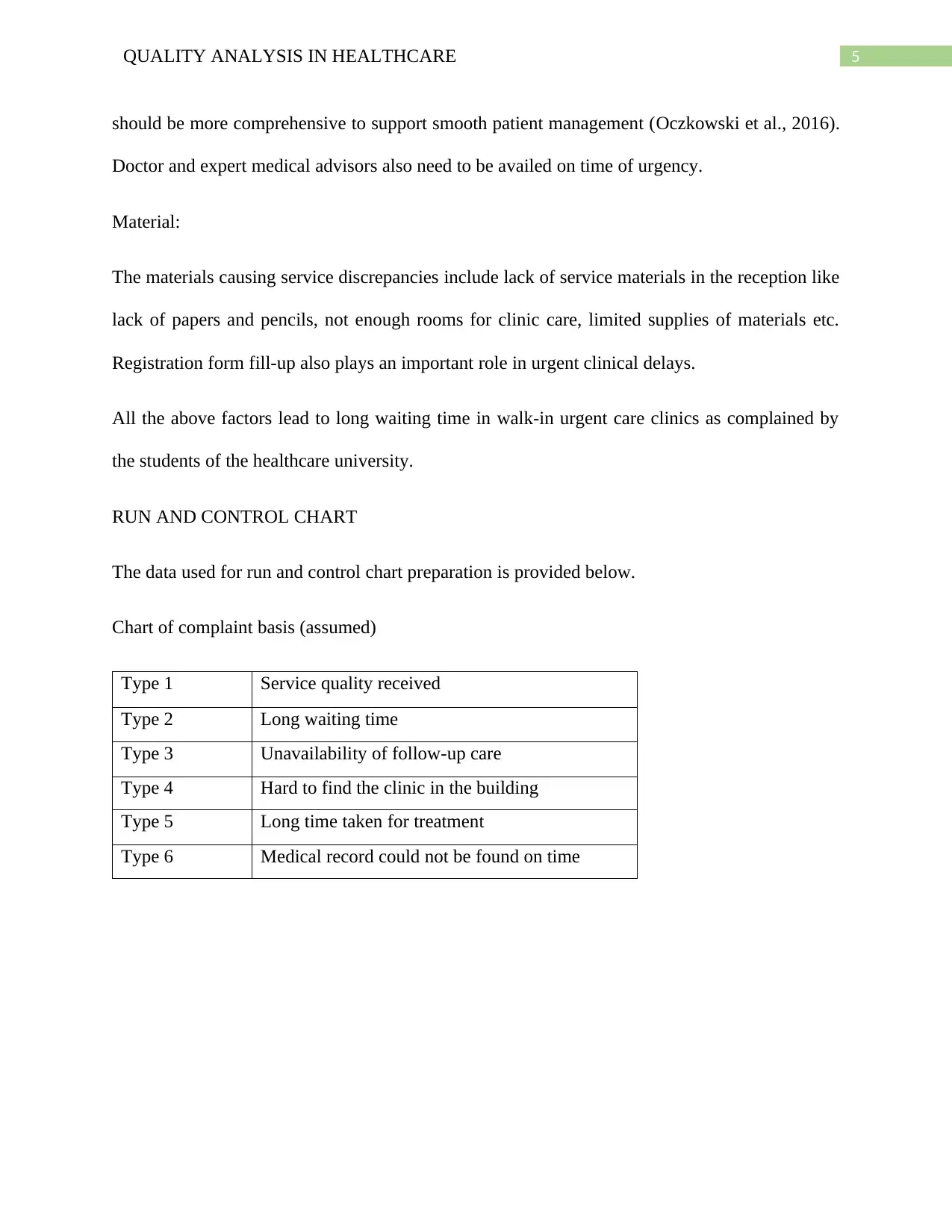
5QUALITY ANALYSIS IN HEALTHCARE
should be more comprehensive to support smooth patient management (Oczkowski et al., 2016).
Doctor and expert medical advisors also need to be availed on time of urgency.
Material:
The materials causing service discrepancies include lack of service materials in the reception like
lack of papers and pencils, not enough rooms for clinic care, limited supplies of materials etc.
Registration form fill-up also plays an important role in urgent clinical delays.
All the above factors lead to long waiting time in walk-in urgent care clinics as complained by
the students of the healthcare university.
RUN AND CONTROL CHART
The data used for run and control chart preparation is provided below.
Chart of complaint basis (assumed)
Type 1 Service quality received
Type 2 Long waiting time
Type 3 Unavailability of follow-up care
Type 4 Hard to find the clinic in the building
Type 5 Long time taken for treatment
Type 6 Medical record could not be found on time
should be more comprehensive to support smooth patient management (Oczkowski et al., 2016).
Doctor and expert medical advisors also need to be availed on time of urgency.
Material:
The materials causing service discrepancies include lack of service materials in the reception like
lack of papers and pencils, not enough rooms for clinic care, limited supplies of materials etc.
Registration form fill-up also plays an important role in urgent clinical delays.
All the above factors lead to long waiting time in walk-in urgent care clinics as complained by
the students of the healthcare university.
RUN AND CONTROL CHART
The data used for run and control chart preparation is provided below.
Chart of complaint basis (assumed)
Type 1 Service quality received
Type 2 Long waiting time
Type 3 Unavailability of follow-up care
Type 4 Hard to find the clinic in the building
Type 5 Long time taken for treatment
Type 6 Medical record could not be found on time
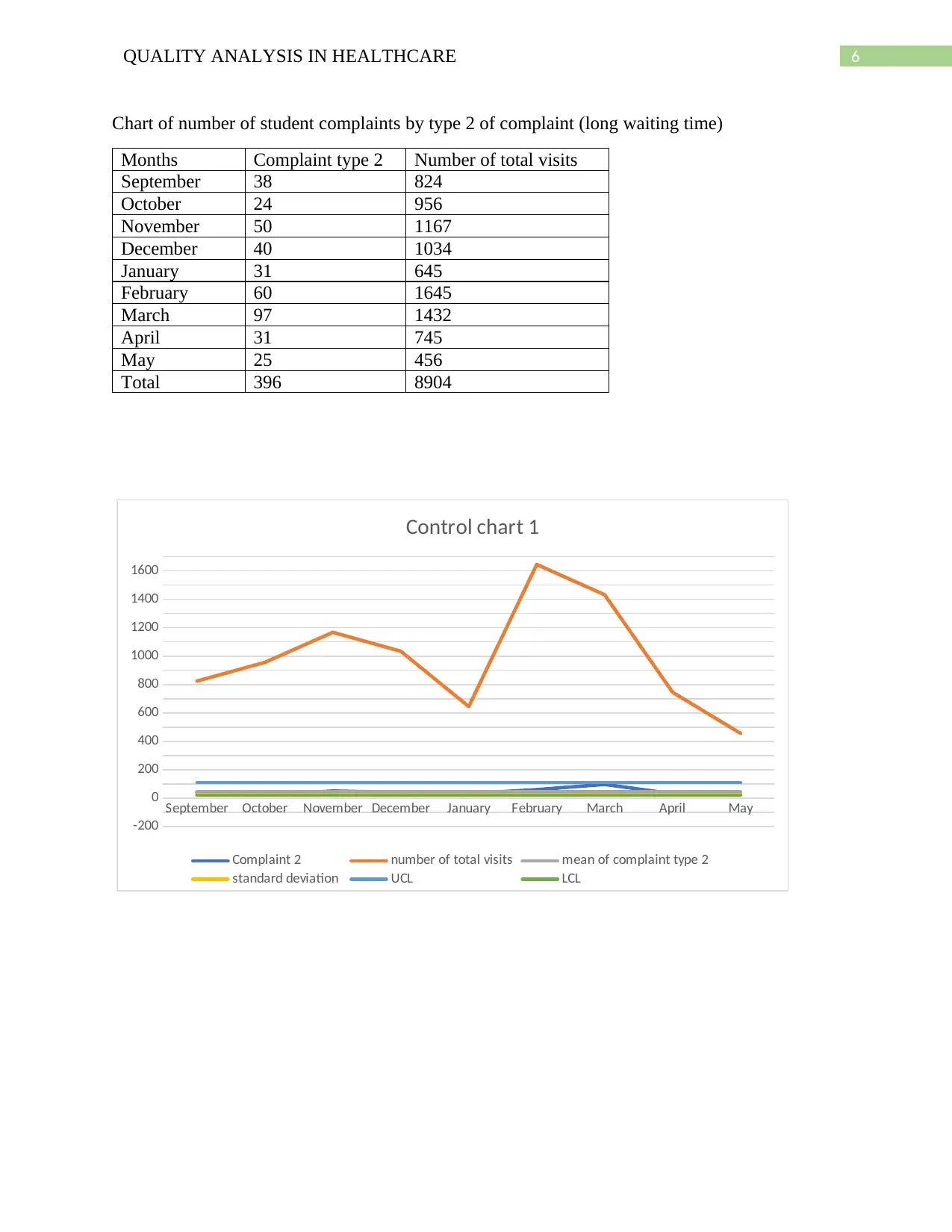
6QUALITY ANALYSIS IN HEALTHCARE
Chart of number of student complaints by type 2 of complaint (long waiting time)
Months Complaint type 2 Number of total visits
September 38 824
October 24 956
November 50 1167
December 40 1034
January 31 645
February 60 1645
March 97 1432
April 31 745
May 25 456
Total 396 8904
September October November December January February March April May
-200
0
200
400
600
800
1000
1200
1400
1600
Control chart 1
Complaint 2 number of total visits mean of complaint type 2
standard deviation UCL LCL
Chart of number of student complaints by type 2 of complaint (long waiting time)
Months Complaint type 2 Number of total visits
September 38 824
October 24 956
November 50 1167
December 40 1034
January 31 645
February 60 1645
March 97 1432
April 31 745
May 25 456
Total 396 8904
September October November December January February March April May
-200
0
200
400
600
800
1000
1200
1400
1600
Control chart 1
Complaint 2 number of total visits mean of complaint type 2
standard deviation UCL LCL
⊘ This is a preview!⊘
Do you want full access?
Subscribe today to unlock all pages.

Trusted by 1+ million students worldwide
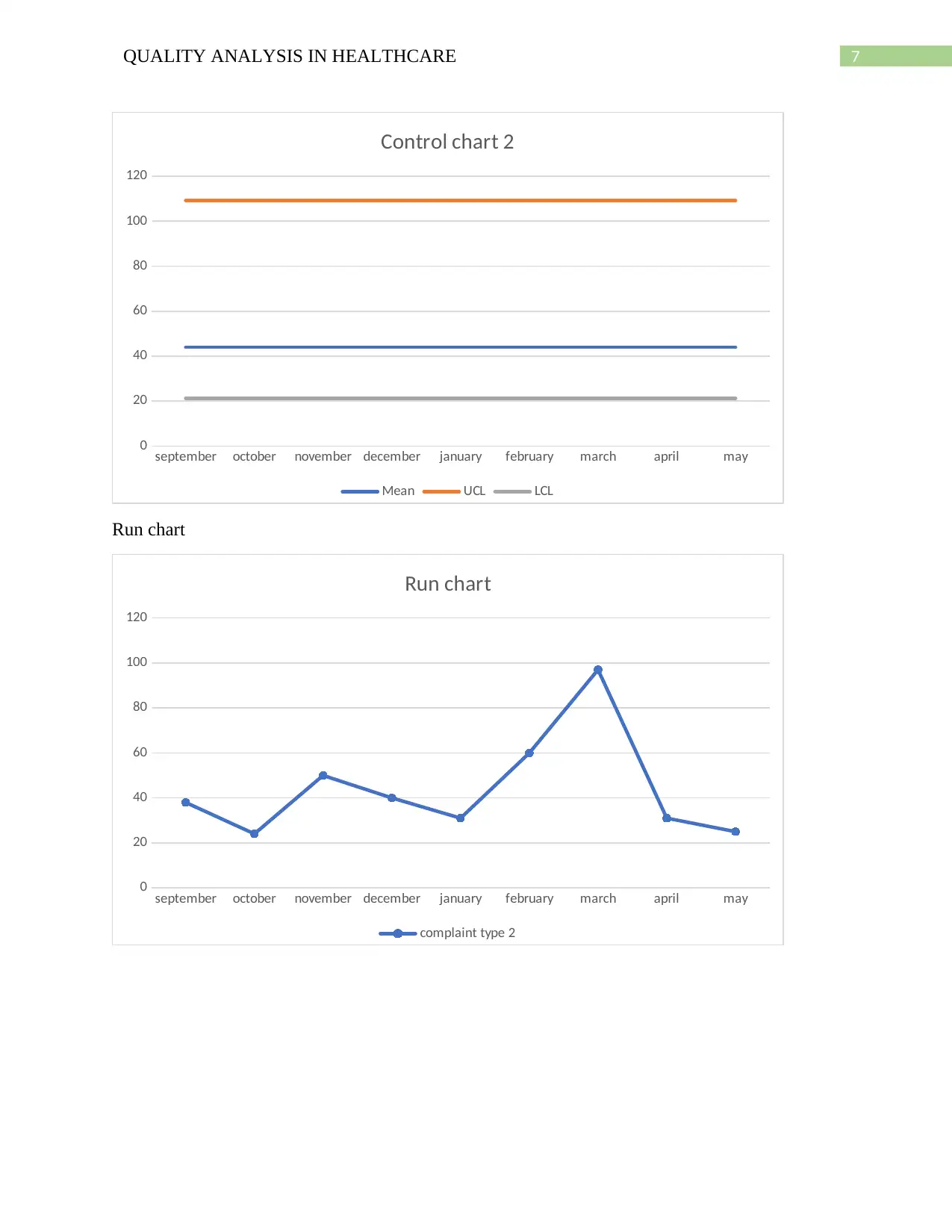
7QUALITY ANALYSIS IN HEALTHCARE
september october november december january february march april may
0
20
40
60
80
100
120
Control chart 2
Mean UCL LCL
Run chart
september october november december january february march april may
0
20
40
60
80
100
120
Run chart
complaint type 2
september october november december january february march april may
0
20
40
60
80
100
120
Control chart 2
Mean UCL LCL
Run chart
september october november december january february march april may
0
20
40
60
80
100
120
Run chart
complaint type 2
Paraphrase This Document
Need a fresh take? Get an instant paraphrase of this document with our AI Paraphraser
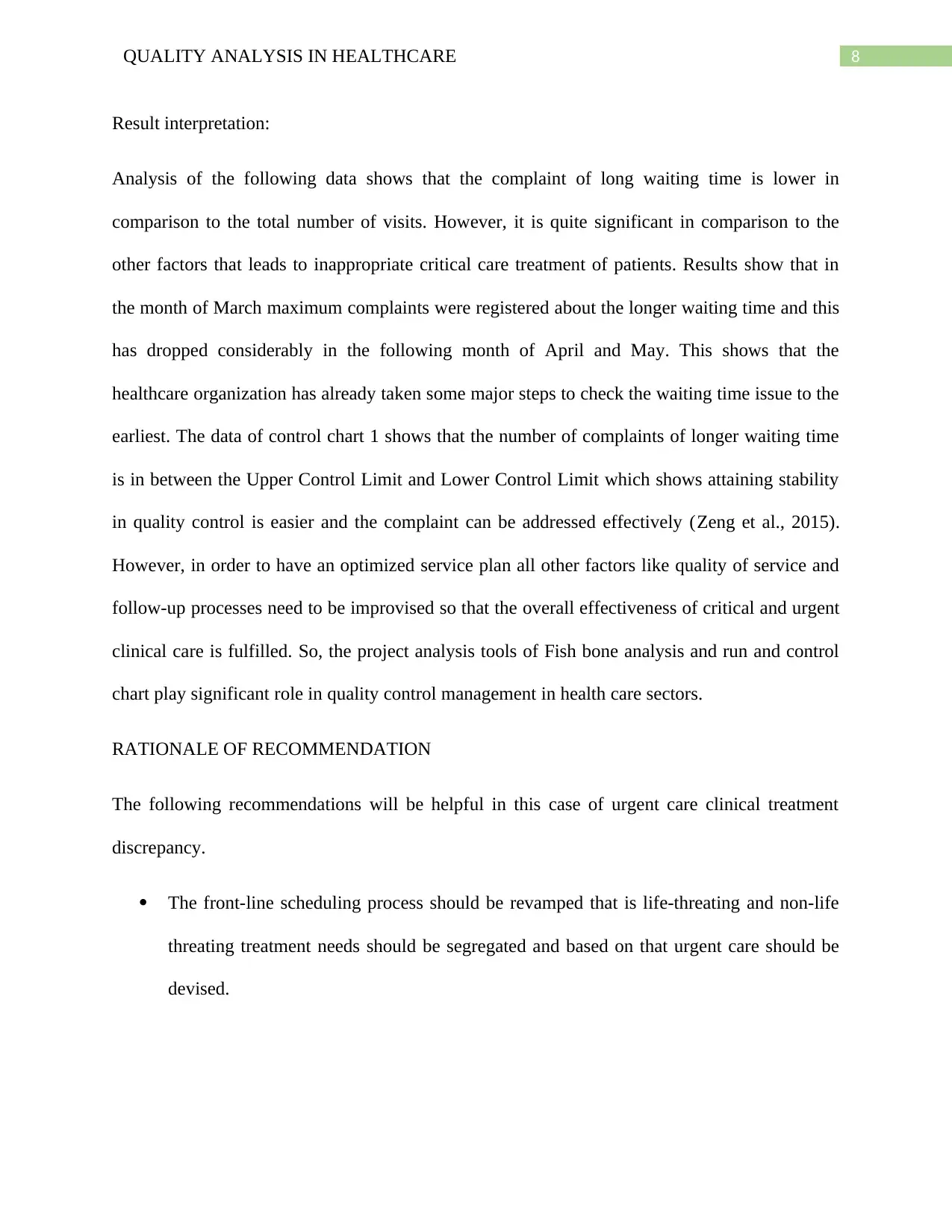
8QUALITY ANALYSIS IN HEALTHCARE
Result interpretation:
Analysis of the following data shows that the complaint of long waiting time is lower in
comparison to the total number of visits. However, it is quite significant in comparison to the
other factors that leads to inappropriate critical care treatment of patients. Results show that in
the month of March maximum complaints were registered about the longer waiting time and this
has dropped considerably in the following month of April and May. This shows that the
healthcare organization has already taken some major steps to check the waiting time issue to the
earliest. The data of control chart 1 shows that the number of complaints of longer waiting time
is in between the Upper Control Limit and Lower Control Limit which shows attaining stability
in quality control is easier and the complaint can be addressed effectively (Zeng et al., 2015).
However, in order to have an optimized service plan all other factors like quality of service and
follow-up processes need to be improvised so that the overall effectiveness of critical and urgent
clinical care is fulfilled. So, the project analysis tools of Fish bone analysis and run and control
chart play significant role in quality control management in health care sectors.
RATIONALE OF RECOMMENDATION
The following recommendations will be helpful in this case of urgent care clinical treatment
discrepancy.
The front-line scheduling process should be revamped that is life-threating and non-life
threating treatment needs should be segregated and based on that urgent care should be
devised.
Result interpretation:
Analysis of the following data shows that the complaint of long waiting time is lower in
comparison to the total number of visits. However, it is quite significant in comparison to the
other factors that leads to inappropriate critical care treatment of patients. Results show that in
the month of March maximum complaints were registered about the longer waiting time and this
has dropped considerably in the following month of April and May. This shows that the
healthcare organization has already taken some major steps to check the waiting time issue to the
earliest. The data of control chart 1 shows that the number of complaints of longer waiting time
is in between the Upper Control Limit and Lower Control Limit which shows attaining stability
in quality control is easier and the complaint can be addressed effectively (Zeng et al., 2015).
However, in order to have an optimized service plan all other factors like quality of service and
follow-up processes need to be improvised so that the overall effectiveness of critical and urgent
clinical care is fulfilled. So, the project analysis tools of Fish bone analysis and run and control
chart play significant role in quality control management in health care sectors.
RATIONALE OF RECOMMENDATION
The following recommendations will be helpful in this case of urgent care clinical treatment
discrepancy.
The front-line scheduling process should be revamped that is life-threating and non-life
threating treatment needs should be segregated and based on that urgent care should be
devised.
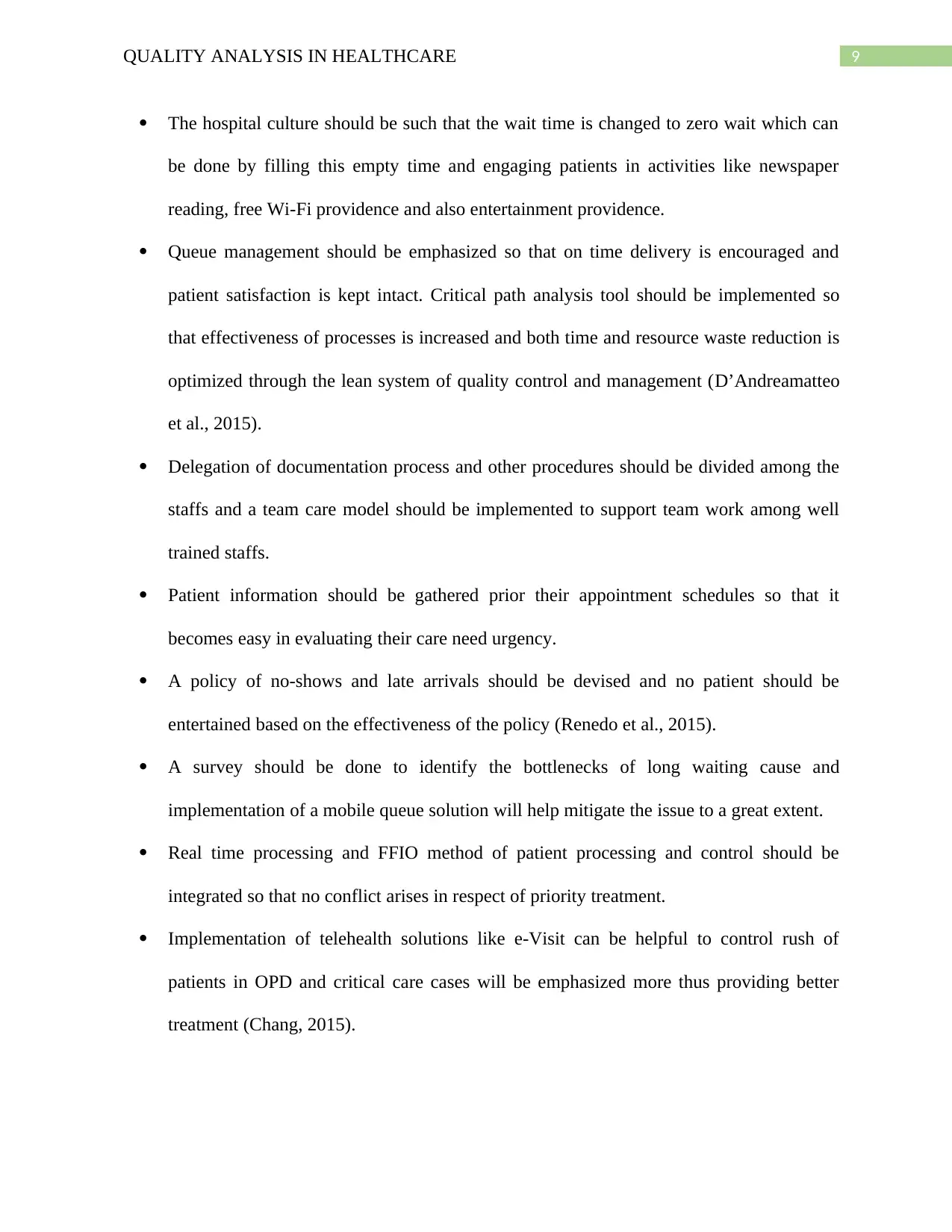
9QUALITY ANALYSIS IN HEALTHCARE
The hospital culture should be such that the wait time is changed to zero wait which can
be done by filling this empty time and engaging patients in activities like newspaper
reading, free Wi-Fi providence and also entertainment providence.
Queue management should be emphasized so that on time delivery is encouraged and
patient satisfaction is kept intact. Critical path analysis tool should be implemented so
that effectiveness of processes is increased and both time and resource waste reduction is
optimized through the lean system of quality control and management (D’Andreamatteo
et al., 2015).
Delegation of documentation process and other procedures should be divided among the
staffs and a team care model should be implemented to support team work among well
trained staffs.
Patient information should be gathered prior their appointment schedules so that it
becomes easy in evaluating their care need urgency.
A policy of no-shows and late arrivals should be devised and no patient should be
entertained based on the effectiveness of the policy (Renedo et al., 2015).
A survey should be done to identify the bottlenecks of long waiting cause and
implementation of a mobile queue solution will help mitigate the issue to a great extent.
Real time processing and FFIO method of patient processing and control should be
integrated so that no conflict arises in respect of priority treatment.
Implementation of telehealth solutions like e-Visit can be helpful to control rush of
patients in OPD and critical care cases will be emphasized more thus providing better
treatment (Chang, 2015).
The hospital culture should be such that the wait time is changed to zero wait which can
be done by filling this empty time and engaging patients in activities like newspaper
reading, free Wi-Fi providence and also entertainment providence.
Queue management should be emphasized so that on time delivery is encouraged and
patient satisfaction is kept intact. Critical path analysis tool should be implemented so
that effectiveness of processes is increased and both time and resource waste reduction is
optimized through the lean system of quality control and management (D’Andreamatteo
et al., 2015).
Delegation of documentation process and other procedures should be divided among the
staffs and a team care model should be implemented to support team work among well
trained staffs.
Patient information should be gathered prior their appointment schedules so that it
becomes easy in evaluating their care need urgency.
A policy of no-shows and late arrivals should be devised and no patient should be
entertained based on the effectiveness of the policy (Renedo et al., 2015).
A survey should be done to identify the bottlenecks of long waiting cause and
implementation of a mobile queue solution will help mitigate the issue to a great extent.
Real time processing and FFIO method of patient processing and control should be
integrated so that no conflict arises in respect of priority treatment.
Implementation of telehealth solutions like e-Visit can be helpful to control rush of
patients in OPD and critical care cases will be emphasized more thus providing better
treatment (Chang, 2015).
⊘ This is a preview!⊘
Do you want full access?
Subscribe today to unlock all pages.

Trusted by 1+ million students worldwide
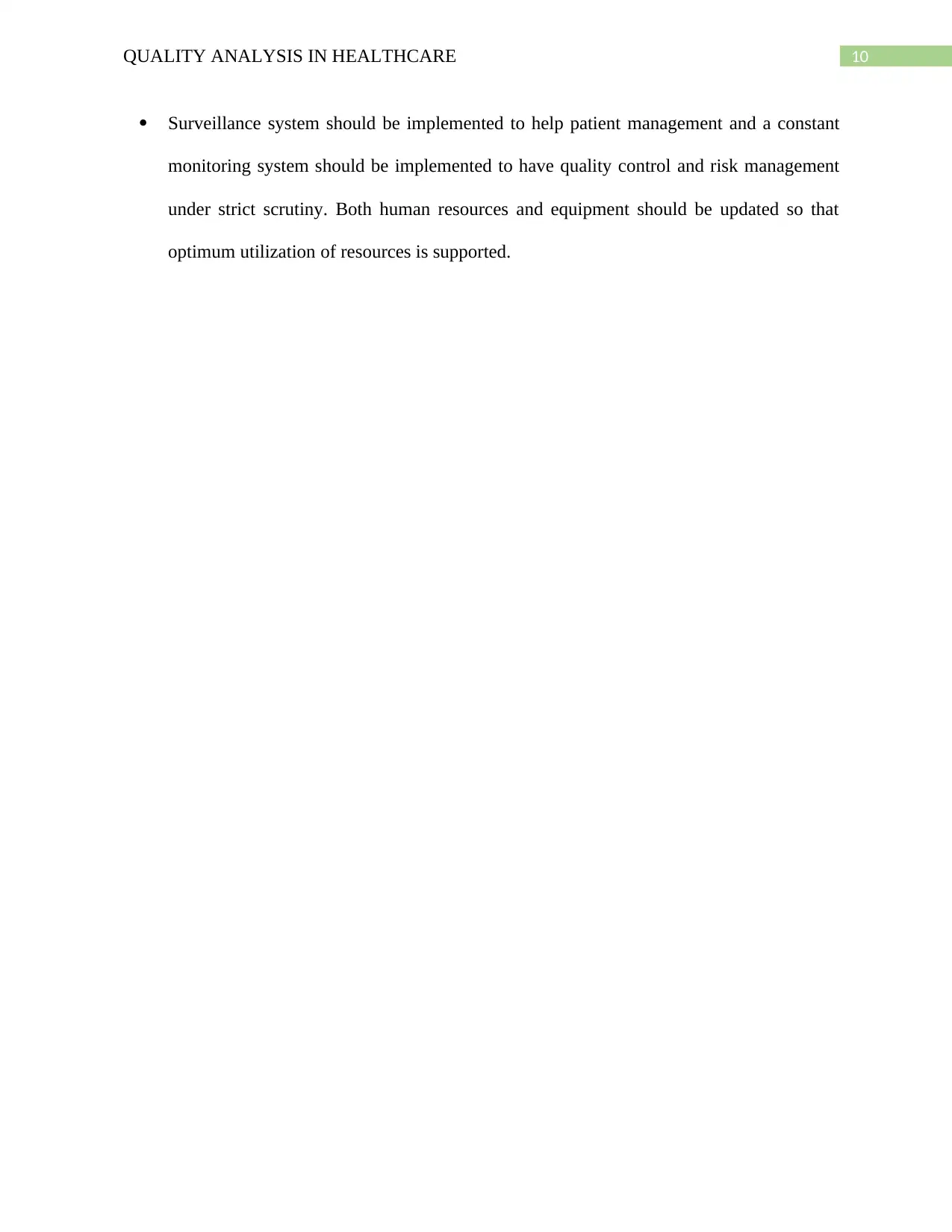
10QUALITY ANALYSIS IN HEALTHCARE
Surveillance system should be implemented to help patient management and a constant
monitoring system should be implemented to have quality control and risk management
under strict scrutiny. Both human resources and equipment should be updated so that
optimum utilization of resources is supported.
Surveillance system should be implemented to help patient management and a constant
monitoring system should be implemented to have quality control and risk management
under strict scrutiny. Both human resources and equipment should be updated so that
optimum utilization of resources is supported.
Paraphrase This Document
Need a fresh take? Get an instant paraphrase of this document with our AI Paraphraser
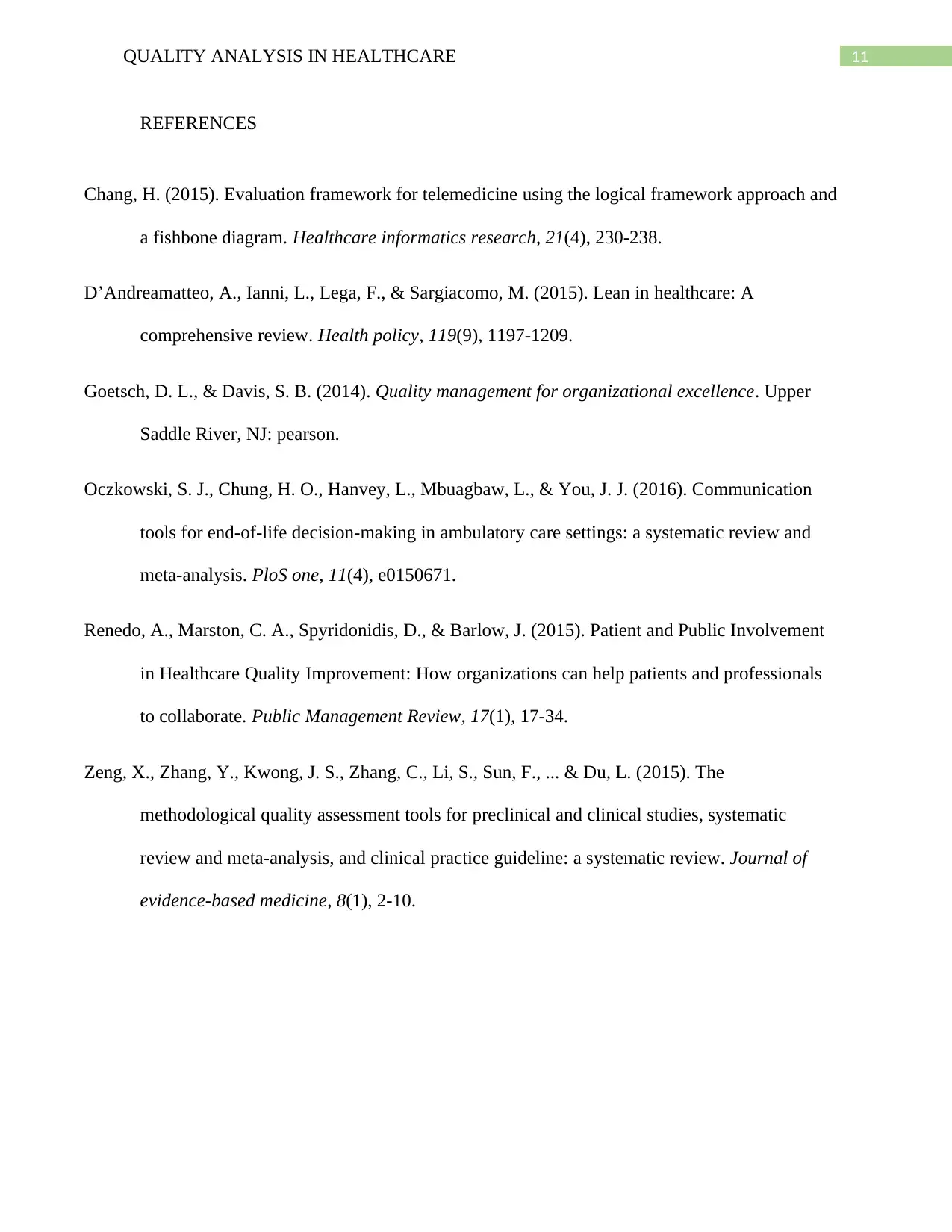
11QUALITY ANALYSIS IN HEALTHCARE
REFERENCES
Chang, H. (2015). Evaluation framework for telemedicine using the logical framework approach and
a fishbone diagram. Healthcare informatics research, 21(4), 230-238.
D’Andreamatteo, A., Ianni, L., Lega, F., & Sargiacomo, M. (2015). Lean in healthcare: A
comprehensive review. Health policy, 119(9), 1197-1209.
Goetsch, D. L., & Davis, S. B. (2014). Quality management for organizational excellence. Upper
Saddle River, NJ: pearson.
Oczkowski, S. J., Chung, H. O., Hanvey, L., Mbuagbaw, L., & You, J. J. (2016). Communication
tools for end-of-life decision-making in ambulatory care settings: a systematic review and
meta-analysis. PloS one, 11(4), e0150671.
Renedo, A., Marston, C. A., Spyridonidis, D., & Barlow, J. (2015). Patient and Public Involvement
in Healthcare Quality Improvement: How organizations can help patients and professionals
to collaborate. Public Management Review, 17(1), 17-34.
Zeng, X., Zhang, Y., Kwong, J. S., Zhang, C., Li, S., Sun, F., ... & Du, L. (2015). The
methodological quality assessment tools for preclinical and clinical studies, systematic
review and meta‐analysis, and clinical practice guideline: a systematic review. Journal of
evidence-based medicine, 8(1), 2-10.
REFERENCES
Chang, H. (2015). Evaluation framework for telemedicine using the logical framework approach and
a fishbone diagram. Healthcare informatics research, 21(4), 230-238.
D’Andreamatteo, A., Ianni, L., Lega, F., & Sargiacomo, M. (2015). Lean in healthcare: A
comprehensive review. Health policy, 119(9), 1197-1209.
Goetsch, D. L., & Davis, S. B. (2014). Quality management for organizational excellence. Upper
Saddle River, NJ: pearson.
Oczkowski, S. J., Chung, H. O., Hanvey, L., Mbuagbaw, L., & You, J. J. (2016). Communication
tools for end-of-life decision-making in ambulatory care settings: a systematic review and
meta-analysis. PloS one, 11(4), e0150671.
Renedo, A., Marston, C. A., Spyridonidis, D., & Barlow, J. (2015). Patient and Public Involvement
in Healthcare Quality Improvement: How organizations can help patients and professionals
to collaborate. Public Management Review, 17(1), 17-34.
Zeng, X., Zhang, Y., Kwong, J. S., Zhang, C., Li, S., Sun, F., ... & Du, L. (2015). The
methodological quality assessment tools for preclinical and clinical studies, systematic
review and meta‐analysis, and clinical practice guideline: a systematic review. Journal of
evidence-based medicine, 8(1), 2-10.
1 out of 11
Related Documents
Your All-in-One AI-Powered Toolkit for Academic Success.
+13062052269
info@desklib.com
Available 24*7 on WhatsApp / Email
![[object Object]](/_next/static/media/star-bottom.7253800d.svg)
Unlock your academic potential
Copyright © 2020–2025 A2Z Services. All Rights Reserved. Developed and managed by ZUCOL.





